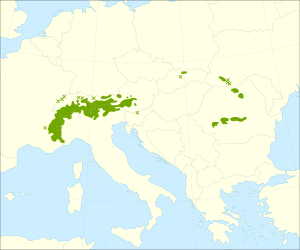Swiss pine facts for kids
Quick facts for kids Swiss pine |
|
|---|---|
 |
|
| Swiss pine growing on the Dachstein, Austria | |
| Conservation status | |
| Scientific classification | |
| Genus: |
Pinus
|
| Species: |
cembra
|
 |
|
| Distribution | |
The Swiss pine (also known as Swiss stone pine or Arolla pine) is a special type of pine tree. Its scientific name is Pinus cembra. It belongs to a group of pines called Strobus.
This tree is famous for growing in cold, high places. It is also known for its tasty seeds, which are like pine nuts.
Contents
What is a Swiss Pine?
The Swiss pine is part of the "white pine" family. Like other white pines, its leaves (called needles) grow in bundles of five. These bundles have a small cover that falls off.
Size and Growth
A grown Swiss pine can be about 25 to 35 meters (82 to 115 feet) tall. Its trunk can be up to 1.5 meters (5 feet) wide. However, these trees grow very slowly. It might take 30 years for a young tree to reach just 1.3 meters (4 feet) tall.
The cones of the Swiss pine hold its seeds, which are also called nuts. These cones are usually 4 to 8 centimeters (1.6 to 3.1 inches) long. It takes two full years for the cones to become ready.
Seeds and Life Span
The seeds are small, about 8 to 12 millimeters (0.3 to 0.5 inches) long. They have a tiny wing, but it's not very useful for flying. Instead, a bird called the spotted nutcracker helps to spread the seeds.
Swiss pines can live for a very long time. Some trees can reach an age of 500 to 1000 years! In nature, they usually start making cones and seeds when they are about 50 years old. If conditions are very harsh, it might take them up to 80 years.
Swiss Pine's Relatives
There is a very similar tree called the Siberian pine (Pinus sibirica). Some scientists think it's just a different type of Swiss pine. The Siberian pine has slightly bigger cones and grows faster. Its needles also have three resin canals, while the Swiss pine has two.

Where Swiss Pines Live
Swiss pines grow in the high mountains of central Europe. You can find them in the Alps and Carpathian Mountains. This includes countries like Austria, France, Germany, Italy, Poland, Romania, Slovakia, Slovenia, Switzerland, and Ukraine.
They typically grow at altitudes between 1,200 and 2,300 meters (about 3,900 to 7,500 feet). They often grow right up to the alpine tree line, which is the highest point where trees can grow.
How Swiss Pines Grow Strong
Swiss pines have a special relationship with tiny underground fungi. These fungi are called mycorrhizal fungi, and they often belong to the Suillus group. This partnership helps the tree grow better and survive, especially when it's young. It's like a team effort!
Uses of the Swiss Pine
The Swiss pine is a very useful tree.
In Gardens and Parks
People often plant Swiss pines in parks and large gardens. They grow steadily and can handle very cold winters, even down to -50°C (-58°F). They are also good at standing up to strong winds.
Pine Nuts and Flavor
The seeds of the Swiss pine are collected and sold as pine nuts. If a Swiss pine is grown in a garden, it might start producing cones after just 12 years. This is much faster than in the wild. To help trees make cones sooner, people can add special fungi (like Suillus luteus) to the soil.
The cones are also used to flavor a type of drink called schnapps. This drink is known as "Zirbenschnaps."
Wood and Art
The wood of the Swiss pine is popular for carving. Since the 1600s, it has been used for beautiful carvings in a place called Val Gardena.
History and Symbols
The cone of the Swiss pine was once a symbol for a Roman legion (a group of soldiers) way back in 15 BC. Because of this, the cone is still used today in the coat of arms for the city of Augsburg in Germany.
Protecting Mountains
Swiss pines are often found in the highest parts of forests. They help to prevent dangerous avalanches and stop soil from washing away. This makes them very important for keeping mountain slopes stable.
Fighting Tree Diseases
Like other white pines from Europe and Asia, the Swiss pine is very good at resisting a disease called white pine blister rust. This fungal disease came from Europe to North America by accident. It has caused a lot of damage to native American white pines. Scientists are now studying the Swiss pine to help make American pines stronger against this disease.
See also
 In Spanish: Pino cembro para niños
In Spanish: Pino cembro para niños



